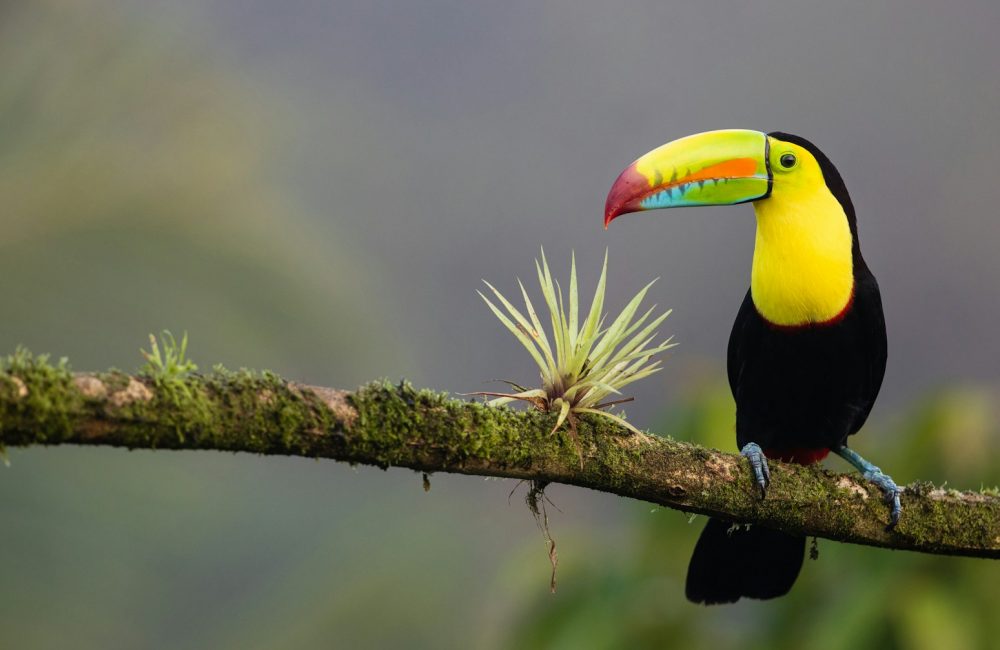Eco-tourism combines travel with sustainability, offering an opportunity to explore the world’s most pristine environments while contributing to conservation efforts and supporting local communities. These destinations are not just about their breathtaking natural beauty—they’re also models of how responsible tourism can preserve ecosystems and create meaningful connections between travelers and the planet.
Here are 13 of the best places to visit for eco-tourism, where you can immerse yourself in nature and experience the positive impact of sustainable travel.
1. Costa Rica
Costa Rica is a global leader in eco-tourism, with over a quarter of its land dedicated to national parks and protected areas. This small Central American country is home to lush rainforests, active volcanoes, and stunning coastlines, offering countless opportunities for eco-friendly exploration.
Visitors can hike through the Monteverde Cloud Forest Reserve, where misty trails wind through a biodiversity hotspot teeming with exotic flora and fauna. Tortuguero National Park is another must-see, famous for its sea turtle nesting sites and mangrove-lined canals. Costa Rica also boasts incredible eco-lodges that prioritize renewable energy, water conservation, and locally sourced food.
Whether zip-lining through forest canopies or observing sloths in the trees, Costa Rica provides an unforgettable experience while showcasing how eco-tourism can harmonize with conservation.
2. Galápagos Islands, Ecuador
The Galápagos Islands are a living laboratory of evolution, home to some of the world’s most unique species. This UNESCO World Heritage Site offers eco-tourists the chance to explore an environment that has remained largely untouched by human activity.
Eco-friendly tours in the Galápagos emphasize sustainability, using small, regulated groups to minimize environmental impact. Visitors can snorkel alongside sea lions and marine iguanas, hike across volcanic landscapes, and encounter iconic species like the giant tortoise. Knowledgeable guides educate visitors about the islands’ fragile ecosystems and the importance of protecting them.
By visiting the Galápagos responsibly, eco-tourists support conservation efforts and contribute to preserving one of the planet’s most extraordinary ecosystems.
3. Botswana
Botswana is a shining example of eco-tourism in Africa, known for its commitment to low-impact, high-value travel. The country’s wildlife-rich landscapes include the Okavango Delta, a UNESCO World Heritage Site, and the Chobe National Park, home to one of the largest elephant populations in the world.
Safari lodges in Botswana are designed with sustainability in mind, often using solar power and eco-friendly construction. Game drives and mokoro (dugout canoe) excursions allow visitors to witness incredible wildlife, from lions and leopards to hippos and crocodiles, without disturbing their natural habitats.
Botswana’s eco-tourism model ensures that revenues from tourism directly benefit conservation initiatives and local communities, making it a standout destination for responsible travelers.
4. Iceland
Iceland’s dramatic landscapes of glaciers, volcanoes, and geysers make it a dream destination for nature lovers. The country’s commitment to renewable energy and sustainable tourism practices has earned it a reputation as one of the world’s most eco-friendly destinations.
Eco-tourists can explore the Golden Circle, which includes Þingvellir National Park, Gullfoss waterfall, and the Geysir geothermal area. Glacial hikes, lava tube explorations, and whale-watching tours are also popular activities. Many tours emphasize conservation education, teaching visitors about Iceland’s unique geology and the importance of protecting its fragile environment.
Iceland’s combination of natural beauty and sustainability sets an example for how tourism can coexist with environmental preservation.
5. Borneo, Malaysia and Indonesia
Borneo is one of the most biodiverse places on Earth, home to lush rainforests and unique species such as orangutans, pygmy elephants, and proboscis monkeys. Eco-tourism in Borneo focuses on preserving these fragile ecosystems while providing visitors with immersive nature experiences.
Guided treks through the rainforest offer opportunities to observe wildlife in their natural habitats, while river cruises along the Kinabatangan River allow close encounters with crocodiles and hornbills. Visitors can also learn about orangutan conservation efforts at rehabilitation centers like Sepilok in Malaysia and Camp Leakey in Indonesia.
Borneo’s eco-tourism initiatives balance adventure with sustainability, making it a must-visit destination for eco-conscious travelers.
6. New Zealand
New Zealand is a paradise for eco-tourism, offering pristine landscapes ranging from rugged mountains and fjords to rolling green hills and beaches. The country’s strong commitment to environmental stewardship and cultural preservation makes it a top choice for sustainable travel.
Eco-tourists can explore Fiordland National Park, home to the iconic Milford and Doubtful Sounds, or hike through Tongariro National Park, a UNESCO World Heritage Site. Maori-guided tours provide insight into the country’s Indigenous culture and its deep connection to the land. Many eco-lodges in New Zealand prioritize renewable energy and sustainable practices.
New Zealand’s breathtaking beauty and commitment to conservation make it an unforgettable destination for eco-tourists.
7. Madagascar
Madagascar is a biodiversity hotspot, with 90% of its wildlife found nowhere else on Earth. From its unique baobab trees to its famous lemurs, the island offers an incredible experience for eco-tourists.
Eco-tours in Madagascar often include visits to national parks like Andasibe-Mantadia, where travelers can spot Indri lemurs, and Tsingy de Bemaraha, known for its dramatic limestone formations. Community-based tourism initiatives allow visitors to engage with local cultures while supporting conservation and sustainable development projects.
Madagascar’s rich ecosystems and focus on responsible tourism make it a destination unlike any other.
8. Rwanda
Rwanda, known as the “Land of a Thousand Hills,” is a beacon of eco-tourism in Africa, celebrated for its remarkable commitment to conservation and sustainable practices. The country’s crown jewel is Volcanoes National Park, home to critically endangered mountain gorillas.
Eco-tourists flock to Rwanda for the once-in-a-lifetime experience of gorilla trekking. Guided by expert trackers, visitors can observe these gentle giants in their natural habitat while contributing to their protection. Rwanda’s eco-tourism model ensures that a portion of the fees goes directly toward conservation efforts and supporting local communities.
Beyond gorillas, eco-tourists can explore Nyungwe Forest National Park, a pristine rainforest offering canopy walks and chimpanzee tracking, or Lake Kivu, a serene destination for kayaking and birdwatching. Rwanda’s commitment to eco-tourism makes it a top destination for those seeking wildlife encounters and sustainable travel experiences.
9. Peru
Peru’s diverse ecosystems and rich cultural heritage make it an exceptional destination for eco-tourism. From the Amazon Rainforest to the Andes Mountains, the country offers a variety of experiences for nature enthusiasts and conservation-minded travelers.
The Peruvian Amazon is a hotspot for biodiversity, with eco-lodges offering guided tours that include canoeing through oxbow lakes, jungle treks, and wildlife spotting. Visitors to the Sacred Valley and Machu Picchu can learn about the Inca civilization while exploring these ancient sites with sustainable tour operators committed to preserving the environment and supporting local communities.
Peru also boasts the Colca Canyon, one of the deepest canyons in the world, where eco-tourists can hike while observing Andean condors soaring overhead. With its combination of natural wonders and cultural treasures, Peru provides a holistic eco-tourism experience.
10. Palau
Palau, a small island nation in the Pacific Ocean, is a global leader in marine conservation and eco-tourism. Its pristine waters are home to vibrant coral reefs, diverse marine life, and the world-famous Jellyfish Lake.
Eco-tourists in Palau can snorkel or dive in the Rock Islands Southern Lagoon, a UNESCO World Heritage Site, where they can encounter manta rays, sharks, and an array of tropical fish. The nation’s “Palau Pledge,” a commitment that every visitor signs, ensures responsible tourism practices and protects its delicate ecosystems.
Palau’s dedication to sustainability extends to its eco-friendly accommodations, which prioritize renewable energy and waste reduction. This island paradise is a must-visit for travelers who want to experience marine beauty while supporting conservation.
11. Namibia
Namibia is a pioneer in eco-tourism, with its vast deserts, rugged coastlines, and diverse wildlife creating a stunning backdrop for sustainable travel. The country is home to numerous community-based conservancies, which empower local people to manage and protect natural resources while benefiting from tourism.
Eco-tourists can explore the iconic Namib Desert, where towering sand dunes meet the Atlantic Ocean, or visit Etosha National Park, known for its vast salt pans and abundant wildlife. The Skeleton Coast offers an otherworldly experience, with shipwrecks and dramatic landscapes providing a unique eco-adventure.
Namibia’s innovative approach to conservation, including initiatives to protect endangered species like black rhinos and cheetahs, makes it a standout destination for eco-tourism.
12. Finland
Finland is a nature lover’s paradise, with vast forests, crystal-clear lakes, and a strong focus on sustainable living. Eco-tourism in Finland revolves around enjoying its pristine wilderness while minimizing environmental impact.
Visitors can experience the magic of Lapland, where they can witness the Northern Lights, stay in eco-friendly lodges, and learn about Sami culture. The country’s national parks, such as Nuuksio and Oulanka, offer hiking, canoeing, and wildlife spotting opportunities, including reindeer, elk, and bears.
Finland’s commitment to renewable energy, low-impact tourism, and preserving its natural beauty makes it an ideal destination for eco-conscious travelers seeking tranquility and adventure.
13. Seychelles
The Seychelles, an archipelago in the Indian Ocean, is a haven for eco-tourism, with its white-sand beaches, turquoise waters, and diverse ecosystems. This tropical paradise has made significant efforts to balance tourism with environmental preservation.
Visitors can explore the Vallée de Mai, a UNESCO World Heritage Site, which is home to the rare coco de mer palm and endemic species like the Seychelles black parrot. Marine conservation is a priority in the Seychelles, and eco-tourists can participate in snorkeling or diving excursions to vibrant coral reefs teeming with life. Island-hopping tours often include visits to conservation-focused resorts that support local communities and protect fragile habitats.
The Seychelles offers a luxurious yet sustainable travel experience, making it a dream destination for eco-conscious travelers.
Conclusion
These 13 destinations showcase the incredible diversity of eco-tourism, from tropical rainforests and vibrant coral reefs to rugged deserts and ancient forests. Each place offers a unique opportunity to connect with nature while promoting conservation and sustainability.
Eco-tourism is more than just travel—it’s a way to support the protection of our planet’s most precious ecosystems and contribute to local communities. Whether trekking through Rwanda’s gorilla habitats, snorkeling in Palau’s pristine waters, or exploring Costa Rica’s lush rainforests, eco-tourism inspires meaningful connections with the natural world and fosters a collective responsibility to preserve it for generations to come.






